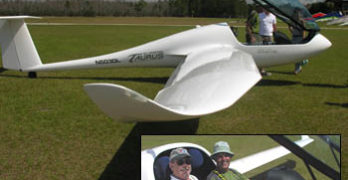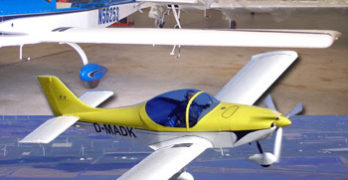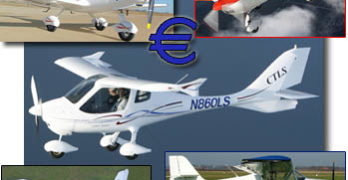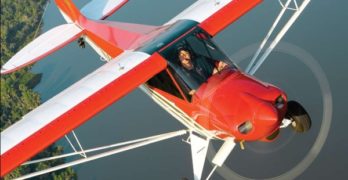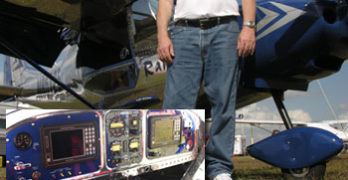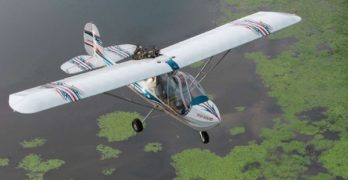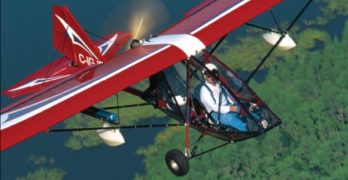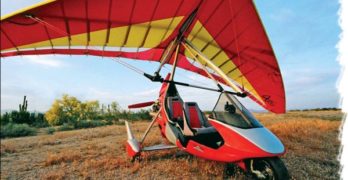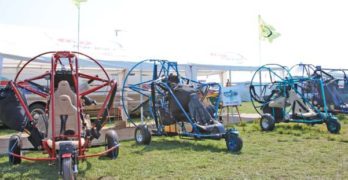Some of you know the Pipistrel line. Americans have seen two of their models: the Sinus and Virus (yep, those awkward, even distasteful names…except representatives prefer to say SEEN-us and VEER-us). Fortunately Taurus is easier on the American tongue, thanks to Ford and its auto model by the same name. *** I discovered Taurus is also easy on the ears as I went for a two-hour soaring flight from Wallaby Ranch with my hang gliding friend, David Ledford. His side-by-side Taurus — roomy for a soaring machine — glides beyond 40:1 and manages a sink rate barely more than 100 fpm. Those numbers translate into plenty of soaring power as we proved on a day with modest convective lift. *** Taurus is a self-launched sailplane, rather than a motorglider like Urban Air’s Lambada or Pipistrel’s own Sinus. To get aloft, we were powered by a Rotax 503 two-stroke engine that fits neatly into a cavity aft of the cockpit.
Search Results for : flight design ct
Not finding exactly what you expected? Try our advanced search option.
Select a manufacturer to go straight to all our content about that manufacturer.
Select an aircraft model to go straight to all our content about that model.
Renewed Breezer II SLSA Ready for Delivery
They are lining up, literally, at Sportsplanes.com’s Plant City, Florida airport (PCM) assembly station. Michael Zidziunas — everyone calls him “Mike Z” — assembled three of the new Breezer II SLSA and arranged for DAR inspection. Mike Z is a well-known flight instructor and licensed mechanic working in the LSA arena. *** Last fall, at the AOPA Expo, Josh Foss of Sportsplanes.com unveiled the new Breezer II. The all-metal low wing was introduced more than a year earlier but disputes over the design rights and manufacturing put a halt to shipments. Since then, German designer Ralf Magnussen found a new investor, Dirk Ketelsen, a builder of windmills for electric power generation. They established a new 17,000 square foot plant near Husum, Germany (west of Hamburg at the North Sea coastline) where Josh reports they can build more than 100 aircraft a year.
High Priced Light-Sport Aircraft; What’s Going On?
Lots of folks are wondering about, or complaining about, the seemingly high prices of Light-Sport Aircraft. Recently a prior editor-in-chief of EAA publications, Scott Spangler, wrote a blog on JetWhine. Scott focused on expensive avionics as one reason LSA cost so much. While a factual observation, I believe the price increase is more complex. *** First, LSA suppliers install equipment like autopilots because buyers ask for them. A large chunk of all LSA are sold to “retiring” GA pilots used to such equipment in their Cessna or Bonanza. Simpler LSA are available; most suppliers have one. But customers are buying the loaded-panel jobs. *** Let’s look closer at those rising prices. Five years ago, in the pre-dawn of SP/LSA, a CT was selling for $60,000. Today it’s $125,000. By far the largest piece of that doubling is the euro’s soaring value compared to the dollar. Were the currencies at parity, that $125,000 would be $80,000.
CubCrafters All-New Sport Cub
Vintage Looks Mated With Modern Materials
Take 25 years of experience
with rebuilding Piper Cubs,
add a new FAA regulation
allowing more flexibility in designing
and producing aircraft, spice the
mixture with many design changes,
and you get CubCrafters’ Sport Cub.
The Yakima, Washington-based company
has created an airplane that retains
the vintage look of a J-3 Cub
but embraces 21st century materials
and technology.
On a warm evening during
the Sun ‘n Fun Fly-In
at Lakeland, Florida, I
flew with CubCrafters’
pilot Clay Hammond. He
identified company President
Jim Richmond as the primary
motivator behind the Sport Cub.
Richmond has been rebuilding Cubs
for 25 years, during which time he
conceived many changes he wanted
to try. Taking into consideration his
height-he’s 6 feet 4 inches tall-he
wanted to make all the improvements
he’d envisioned for the venerable
Cub, and he wanted the airplane
to fit him.
A Thoroughly Modern Cub
CubCrafters took on the redesign
of the 50-year-old airplane using
modern materials and engineering
software not available to Piper engineers
when the J-3 was created.
AERO LTD.
Aero Ltd.
Based in Poland, Aero Ltd.
was founded in 1994. The
company’s mission is to bring
to market an inexpensive
two-seat aircraft for basic
training and tourism. Tomek
Antoniewski founded Aero
Ltd. in Warsaw, Poland, and
functions as the company’s
CEO. He is also the lead
designer of AT aircraft. He first
constructed the AT-1 as part
of a master’s degree thesis
while in the Warsaw University
of Technology’s Aeronautical
Department. The AT-1 is a
single-seat low-wing plane that
accumulated 2,500 hours of
flying time.
In 1996, Antoniewski created
the AT-2, using experience
accumulated during the earlier
project. Both projects led to
the present-day AT-3. Aero
built one AT-3 for flight testing
and another for static testing.
The prototype AT-3 has flown
1,500 hours in basic training
missions in the Warsaw
Aeroclub. The whole structure
of the AT-3, which was the
basis for the G-700S, was
designed in CAD.
To assist with the
manufacturing of the AT
line, Aero and Antoniewski
have attracted several
seasoned aviation
professionals with years of
design, manufacturing, and
certification experience.
On the Rampage…Yet Another SLSA from Skykits
Rampage looks so dissimilar to its predecessors from Skykits that it took a second glance to make the connection. While it shares the STOL wing devices with versions of the Savannah, Rampage has a sleeker look that might broaden the appeal of these short takeoff and land designs from ICP of Italy. *** For those who got to see the new model at Sebring the airplane’s lines weren’t alone to admire. Deep blue paint was used in strategic accent to highly polished aluminum on most of the fuselage; Rampage gleamed brilliantly in Florida’s warm sun. The finish was brought inside where a polished aluminum instrument panel frame contrasted with royal blue inset subpanels (photo). Skykits director Eric Giles reported that the bright metal inside had not caused reflective problems on their long flight from western Canada. *** Rampage, the fourth SLSA model for which Skykits has gained airworthiness, uses electrically deployed leading edge slats to continue the impressive performance of the Savannah models.
The Sport Hornet
Is It the First Ultralight SLSA?
Among fixed-wing airplanes, the Sport Hornet from Higher Class Aviation
may be the first ultralight-type airplane to achieve special light-sport
aircraft (S-LSA) status. Several weight-shift trikes and a few powered
parachutes also have made the jump, making declarations of meeting the
ASTM industry consensus standards.
As company owner Robert Gaither and his team made the Hornet ready for the
LSA market, the airplane was put through a series of changes resulting in the
name Sport Hornet.
From Hornet to Super Hornet to Sport Hornet
Jim Millett, of U.S. Light Aircraft,
designed the original Hornet thinking
he could improve upon the Quad
City Ultralight’s Challenger. His was
a ground-up different design that had
only the look of a Challenger. Much
of what Jim created remains on the
Sport Hornet of today, but much has
also changed, sometimes to meet
S-LSA requirements and sometimes
because it was the right thing to do.
Lightplane Offerings From Canada
The Beaver and Chinook ultralight-like aircraft are arguably two of the bestknown
lightweight designs coming from Canada. Aircraft Sales and Parts, more
commonly known as ASAP, is the company that rescued and now manufactures
and sells these designs, along with a powered parachute from its sister company,
Summit Powered Parachutes. The tale of ASAP’s involvement with the Chinook
and Beaver offers insight into ultralight progress – Canadian style.
A History Lesson
Perhaps the most famous ultralight
to come out of Canada is the Beaver.
With a reported 2,200 flying units
since the early 1980s, it’s a successful
design. However, due to corporate
missteps by the companies that
owned the brand, the Beaver series
was nearly lost. Originally, the Beaver
models were manufactured by
Spectrum Aircraft Inc. Reorganization
left the ultralight in the hands
of a company called Beaver RX Enterprises.
In 1993, that company closed
its doors and stranded thousands of
Beaver aircraft owners, along with
all the dealerships that sold and serviced
them.
A Sport Bike of the Air
First weight-shift S-LSA sets the bar high
In street vernacular, the term
“crotch rocket” refers to a lean,
lightweight, high-performance
motorcycle. Sometimes called sport
bikes, these machines have become
radically snazzy in modern years by
the addition of rakish body panels.
Sport bikes accelerate like a rocket.
They corner tightly, and they turn
heads wherever they go.
The first weight-shift trike to earn
special light-sport aircraft (S-LSA) approval,
the Air Creation Tanarg might
be compared to just such a vehicle. In
fact, that’s precisely how its French
manufacturer describes its newest
machine.
Yet, while sport bikes are touchy
and have less margin for error than
other motorcycles, Air Creation’s flying
sport bike is highly stable with predictable
handling. Compare Tanarg’s
performance to other trikes, and it
comes out as a top-of-the-line entry.
The name Tanarg comes from the
highest mountain range in the Ardeche
region of southern France, not
far from the Air Creation factory.
To Infinity…and Beyond!
The world of light-sport
aircraft (LSA) includes five
classes of aircraft-airplanes,
gliders, powered parachutes, weightshift-
control aircraft (commonly
called trikes), and lighter-than-air
aircraft (balloons and airships).
While fixed-wing airplanes may be
the most prolific, they are not the
only way for flight enthusiasts to
take to the sky. Weight-shift trikes
and powered parachutes (PPCs) are
also popular modes of flights. Each
offers a different experience to pilot
and passenger.
Some fixed-wing pilots claim
no interest in powered parachutes.
While PPCs certainly aren’t fast,
they do offer one of the best viewing
platforms in aviation and have
attracted a higher percentage of
non-pilots as buyers than any other
aviation segment. That fact alone
should cause more aviators to look
closely at them.
So far three powered parachute
companies have obtained special
LSA (S-LSA) approval for their
models. The first to achieve this
was the Summit 2 from Summit
Powered Parachutes in April 2006.
- « Previous Page
- 1
- …
- 117
- 118
- 119
- 120
- 121
- …
- 145
- Next Page »


